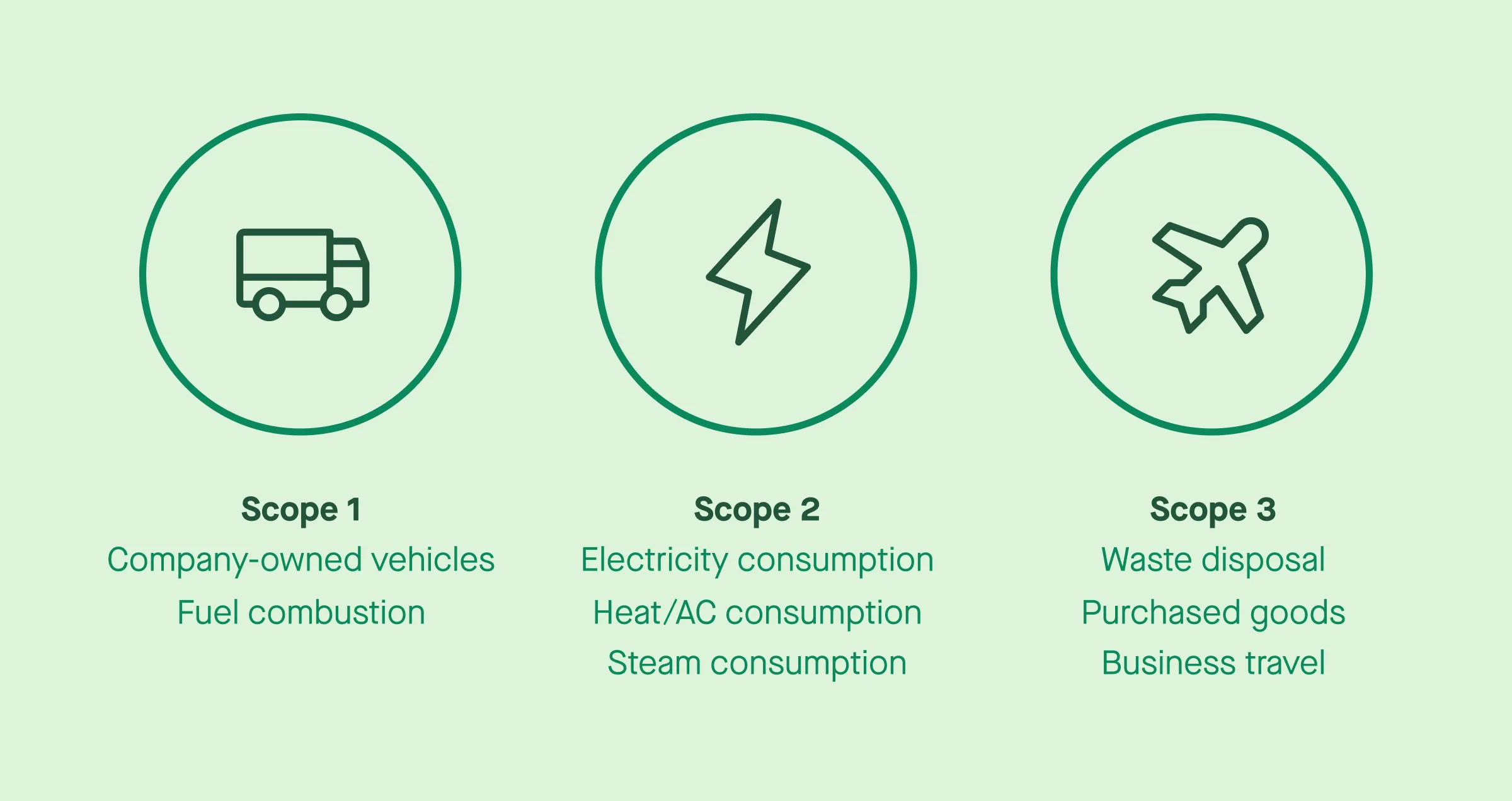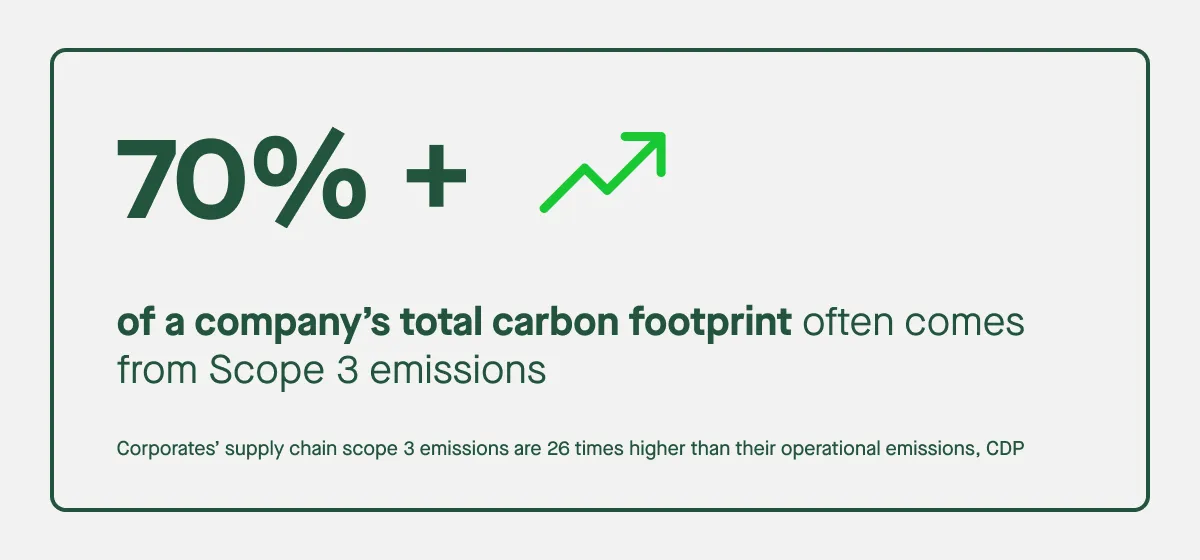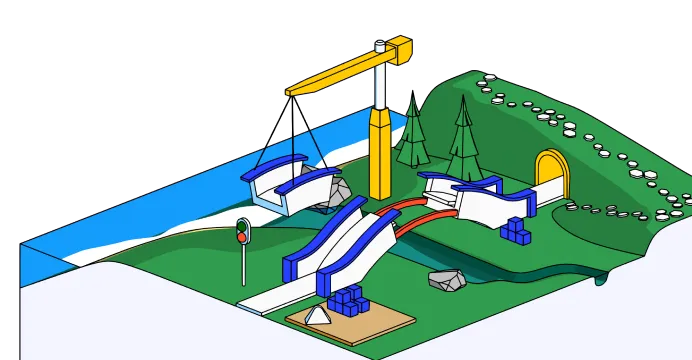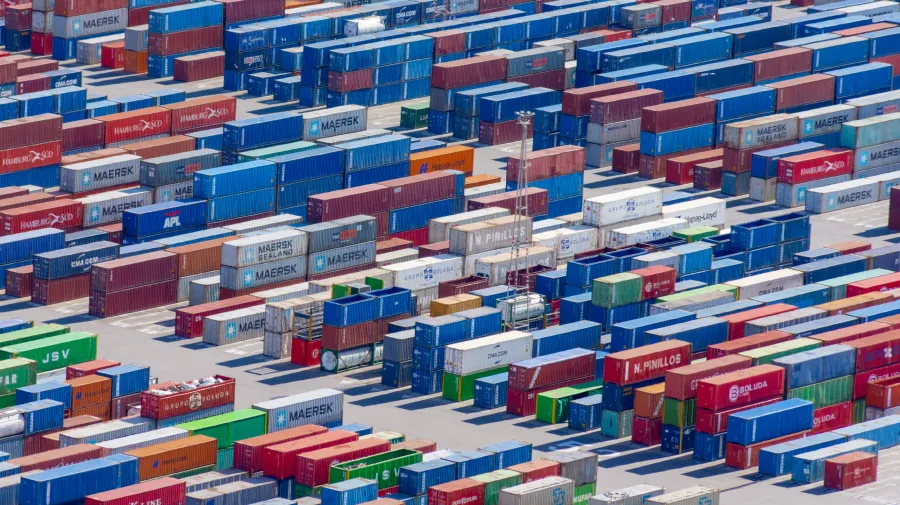What is Scope 3? A recap
Scope 3 emissions refer to indirect greenhouse gas emissions that occur outside a company’s direct operations but still fall within its value chain. These emissions come from sources the company doesn’t own or control, but that are essential to how it does business. Scope 3 covers a wide variety of emission sources throughout the value chain, making it complex to track and report comprehensively.
Common examples of Scope 3 emissions include:
- Purchased goods and services
- Business travel
- Employee commuting
- Use of sold products
- Waste generated in operations
- Upstream and downstream transportation
- Investments and leased assets
Scope 3 differs from:
- Scope 1 – direct emissions from owned or controlled sources (e.g. company vehicles, on-site fuel use)
- Scope 2 – indirect emissions from the generation of purchased electricity, heat, or steam

What should you look for in Scope 3 software?
Choosing the right Scope 3 software means finding a platform that can handle the complexity and scale of value chain emissions, while also supporting regulatory compliance and reduction planning. Key features to look for include:
- Category-level coverage: Ability to track all 15 Scope 3 categories defined by the GHG Protocol, from purchased goods to end-of-life treatment.
- Supplier engagement tools: Built-in workflows or portals to collect primary data directly from suppliers, not just estimates.
- Emission factor integration: Access to reliable emissions databases (e.g. DEFRA, EPA, ADEME) for accurate, standardised calculations, with support for appropriate calculation methods—including the three methods: fuel-based, distance-based, and spend-based approaches. The software should enable users to estimate emissions when primary data is unavailable by applying relevant emission factors.
- Use of secondary sources: Incorporation of secondary sources, such as life cycle assessment datasets and academic studies, to improve the quality and comprehensiveness of emissions data.
- Data quality and auditability: Support for data lineage, confidence scoring, transparent methodologies, and ensuring accuracy in emissions data collection and aggregation from suppliers.
- Scenario analysis: Tools for scenario planning to model the impact of procurement changes, supply chain interventions, reduction targets, and sustainability targets, allowing organizations to forecast and optimize their strategies.
- Reporting alignment: Built-in templates and tags to align with CDP, ISSB (IFRS S2), CSRD, and other frameworks, supporting sustainability reporting and the ability to report emissions for compliance purposes.
- Automation and scalability: Ability to ingest and process large volumes of data across business units and geographies, enabling data driven decisions and providing actionable insights for continuous improvement.
- Comprehensive tracking: Tools to monitor energy consumption and waste generation as part of robust carbon accounting tools, ensuring all relevant environmental metrics are captured.
- Expert support: Access to expert support for implementing and maintaining the software solution, helping organizations navigate carbon accounting, reporting, and decarbonisation processes.
- Regulatory compliance: The best software solutions help ensure compliance with evolving regulations, such as the CSRD, and align with international sustainability frameworks.
What are the top Scope 3 measurement software solutions?
1. Sweep: Scalable, collaborative Scope 3 management
Sweep helps organizations centralize and manage Scope 3 emissions across complex value chains. The platform makes it easy to collect supplier data, engage partners in reduction efforts, and stay compliant with evolving reporting standards.
Key features:
- Easy data collection from suppliers across all 15 Scope 3 categories
- Collaborative reduction tools to set shared targets and track progress
- Free supplier access, removing participation barriers
- Enterprise-grade security (SOC-certified, ISO 27001-compliant)
Best for: Companies with distributed operations and complex supply chains that want to scale supplier engagement, reduce emissions collaboratively, and ensure high-quality, audit-ready Scope 3 data—without adding cost or friction for partners.
2. Persefoni: Carbon accounting for finance-led teams
Persefoni offers a robust carbon accounting platform built around regulatory compliance and audit-ready reporting—especially for financial institutions and large enterprises.
Key features:
- Automated Scope 3 calculations using spend-based and activity-based methods
- Finance-first interface, designed to align sustainability with risk and investment workflows
- Built-in regulatory alignment with SEC, CSRD, and ISSB reporting formats
- Strong audit trail and controls, ideal for regulated industries
- Enterprise onboarding support, with tailored implementations for complex data systems
Best for: Organizations prioritising auditability and financial-grade reporting over supplier collaboration or flexible data inputs.
3. Normative: Target-driven emissions insights
Normative focuses on precise emissions calculations and reduction planning, supported by its proprietary database and partnerships.
Key features:
- Carbon Network integration to request and collect primary emissions data from suppliers
- Hotspot and reduction scenario analysis to identify key areas of impact
- Science-based target alignment with tools to model emissions pathways
- Pre-built compliance outputs for frameworks like CDP, CSRD, and SBTi
- Supplier engagement via structured surveys and external data enrichment
Best for: Companies looking to build emissions strategies around data modeling and SBTi alignment, though with more limited platform access for suppliers compared to Sweep.
4. Greenly: Automated Scope 3 tracking for procurement-led teams
Greenly combines supplier engagement tools with automated data matching and lifecycle analysis to simplify Scope 3 reporting.
Key features:
- Automated supplier matching using a 150k+ emissions factor database
- LCA-based hotspot analysis to identify and model carbon reduction opportunities
- Custom supplier questionnaires aligned with SBTi, CSRD, and CBAM
- Regulatory-ready reports for frameworks like TCFD, CSRD, and IFRS
Best for: Procurement or sustainability teams looking to automate Scope 3 tracking and engage suppliers with tailored, compliance-ready tools.
5. Watershed: End-to-end carbon management for large enterprises
Watershed offers a robust platform for measuring, reporting, and reducing Scope 1, 2, and 3 emissions at scale.
Key features:
- Audit-grade Scope 3 data engine with wide emissions factor coverage
- Supply chain module to engage vendors and collect emissions data quickly
- Integrated reduction tools including target-setting and clean energy projects
- Regulatory-ready reporting aligned with CDP, CSRD, TCFD, and more
Best for: Large enterprises looking for an all-in-one solution to manage and act on carbon data across global operations and supply chains.
6. Plan A: Carbon accounting with science-based reduction planning
Plan A offers a robust platform for carbon accounting, target-setting, and compliance-aligned reporting.
Key features:
- Automated data collection across Scope 1, 2, and 3
- Certified carbon calculations aligned with the GHG Protocol
- LCA-based hotspot analysis and scenario modelling
- Science-based targets and decarbonisation planning
- CSRD, CDP, and TCFD-ready reports
Best for: Midsize to large companies seeking a science-led, compliance-focused platform with strong reduction planning tools.
Final thoughts
As Scope 3 emissions continue to dominate the carbon footprint of most companies, investing in the right sustainability software is essential. The best platforms in 2025 don’t just offer automated calculations; they combine an intuitive interface with powerful features that help organisations meet their sustainability goals across the full scope of emissions. From supplier engagement to regulatory reporting, these tools turn complexity into clarity, enabling data-driven insights and actionable strategies. Whether you’re just starting your Scope 3 journey or scaling an enterprise-wide programme, the right software can make the difference between compliance and true impact.






